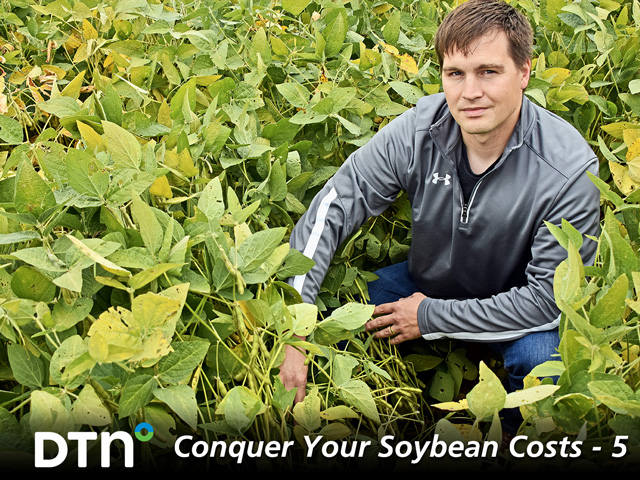Conquer Your Soybean Costs - 5
Variable Soybean Seeding Trims Costs
When Mother Nature cooperates, variable-rate research proves soybean growers can plant 100,000 seeds per acre to grow 75,000 uniform plants for optimum yield.
But, given spring and summer weather extremes, soil variables and aversion to risk, farmers are planting soybeans at varying flat rates -- from 100,000 to 180,000 plants per acre.
Low commodity prices continue to drive growers, such as David Beck of St. James, Minnesota, to reduce input costs. Lower soybean seed prices in the past two to three years have helped, yet many farmers want to decrease seeding rates further as long as they can maintain yield.
"As long as we can keep an acceptable final stand of around 120,000 to 125,000 plants per acre, we will continue to work rates lower, just no big reductions," Beck said.
He plants 160,000 seeds per acre for his 15-inch-row drilled no-till soybeans and 140,000 for his drilled conventional tilled beans. "On the advice of our crop consultant, we planted a couple of fields at 130,000. This gave us a final stand of around 110,000 to 115,000, so we'll see if the yields go down. Some years we have just as good of yields with thinner stands, depending on the soil types and varieties," Beck added.
Crop consultant Stephan Melson, who works with Beck and other farmers across four counties in southern Minnesota and northern Iowa, said more farmers are seeding below the normal 140,000 seeds per acre. "Seeding rates are trending lower except when planting earlier or into cooler, wetter no-till situations where there's going to be more stand loss."
WEATHER RISKS ADD ANXIETY
P[L1] D[0x0] M[300x250] OOP[F] ADUNIT[] T[]
Further north, crop consultant Curt Burns said weather is the biggest issue that keeps more farmers from bringing down soybean seeding rates.
"In our heavy clay soils, there's always a chance for hail or windstorms or smacking, packing rains that can quickly cut stands by a third," Burns said. "If we start at 110,000 plants or less, and lose a third or more, we're in a replant or interseed situation. So, my growers often reduce their replant risk and seed 135,000 to 150,000 seeds per acre."
In Arkansas and the Mid-South, current soybean seeding rate trends are around 140,000 to 150,000 seeds per acre, said University of Arkansas System Division of Agriculture Extension soybean agronomist Jeremy Ross.
"I typically tell growers that a seeding rate from 110,000 to 120,000 will get you about 95% of maximum yield, with 140,000 to 150,000 delivering 99%," he said. "And, for growers planting early (late February through early March) or later (after June 1), I recommend bumping up the population by 10 to 15%."
Ross also recommends seed treatments especially on lower populations. Seventy percent of the time there's a statistical stand and yield increase by using fungicide and insecticide treatments, he added.
Growers in the Mid-South should also consider inoculants when planting in mid-May and June, Ross added.
"We're a bit warmer than the Midwest, which increases our insect and disease complex," he continued. "And, some years we see more issues with seed germination and accelerated aging scores, adding to the need for treatment to protect the stand."
BEST SEEDING RATES
Researchers and farmers who have varied seeding rates understand that higher populations in lower-productivity field zones are more agronomically optimal; the same is true for lower rates in higher-productivity areas.
Research has shown increased profit potential when using variable-rate planter technology. The challenge is identifying different productivity zones within fields to capture spatial variability based on various data layers like soil properties, fertility, topography and yield history.
A 2018-19 University of Minnesota research experiment aimed to match such zones with strip trials of five different seeding densities from 75,000 to 175,000 was conducted on two farms. Graduate student Leanna Leverich worked with Extension soybean agronomist Seth Naeve to evaluate yield response to seeding rates and identify key field properties that influence spatial variability.
"We found a lot of field variability, where optimal seeding density could be anywhere from 75,000 to 175,000 plants per acre," Leverich said.
The lowest seeding rates were statistically the lowest yield on a whole field average at Site 1, Leverich reported. At Site 2, the yield was greater in 2018 on average (64.9 bushels per acre) than 2019 (47.5 bpa), likely because of pressure from white mold, late planting and other agronomic factors. The opposite was true at Site 2: 75,000 seeds produced the highest yields in 2018, and 100,000 seeds delivered the best yields on average in 2019.
ECONOMIC DENSITY ADDED PROFIT
University of Minnesota researchers went beyond just bushel results to find the economic optimum seeding density (EOSD) for each 1-acre block on each site by year.
Using a specific EOSD for every acre led to the potential average gain or cost savings of $18.55 per acre at Site 1 in 2018 compared to the farmers' flat rate of 160,000 seeds per acre. In 2019, Site 1 had an average gain of $21.77 compared to the farmers' flat rate. At Site 2 in 2018, the EOSD saved $17.04 per acre, Leverich explained.
The researchers are now going after the real challenge: determining how to predict future seeding rate responses on every acre.
"These results highlight the importance of going beyond agronomic optimum seeding density to understand the economic optimum seeding density for greatest on-farm gains," Leverich said. "This leads to a clear need to identify factors that impact yield to develop prescriptions for variable-rate planting."
(c) Copyright 2020 DTN, LLC. All rights reserved.






